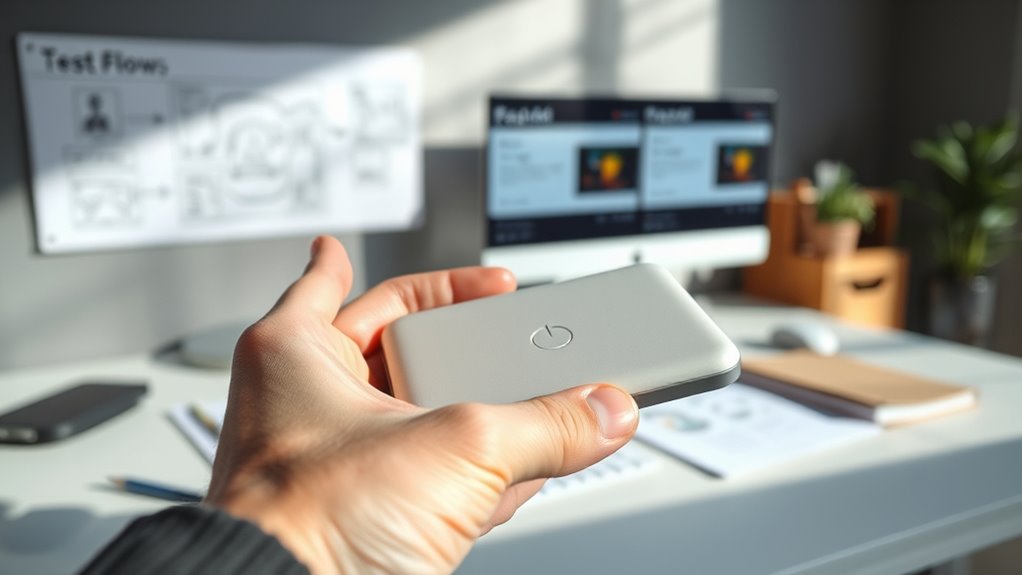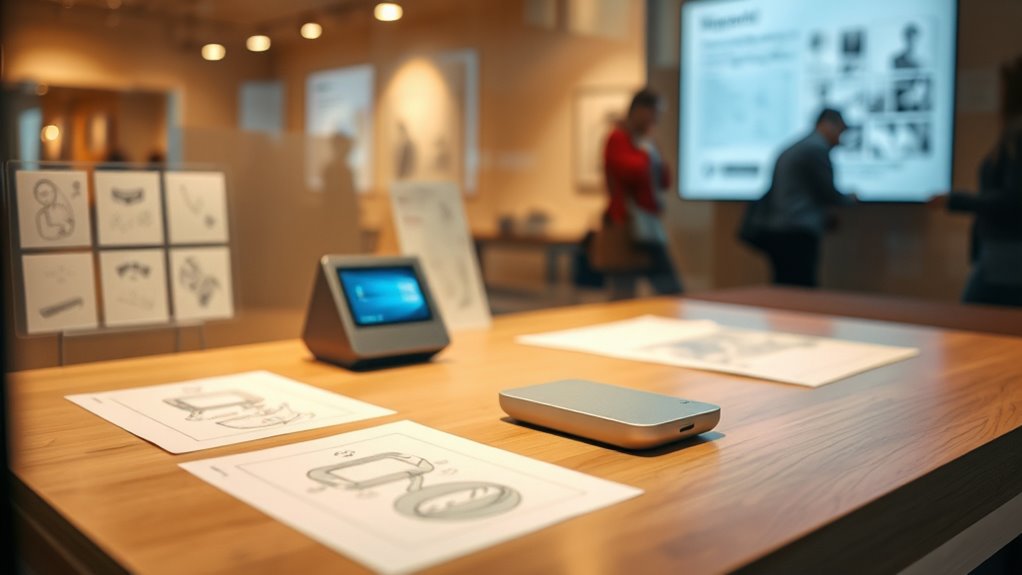When you use pretotyping, it’s vital to stay honest about your intentions and avoid misleading stakeholders or customers. Faking may be acceptable if it’s transparent and clearly communicates your goals, but crossing into deception—like overhyping features or hiding limitations—breaks ethical boundaries. Protect your trust and reputation by balancing quick validation with authenticity. To navigate these nuances and keep your approach responsible, keep exploring the key principles behind ethical pretotyping.
Key Takeaways
- Transparency about pretotyping methods and limitations maintains ethical standards and preserves stakeholder trust.
- Deceptive faking, such as overstating features or hiding prototype limitations, crosses ethical boundaries.
- Respecting intellectual property and legal regulations is essential to avoid legal violations during pretotyping.
- Clear intent focused on honest feedback and validation distinguishes ethical pretotyping from misleading practices.
- Cultural sensitivities and authenticity markers help prevent misunderstandings and uphold moral responsibilities.
Understanding Pretotyping and Its Purpose

Have you ever wondered how startups test new ideas without wasting too much time or money? That’s where pretotyping comes in. It’s a method focused on quick, inexpensive experiments to validate market interest before fully developing a product. Pretotyping helps you achieve market validation early, ensuring there’s demand for your concept. It accelerates innovation by letting you test hypotheses rapidly, saving resources and guiding your next steps more effectively. Instead of investing heavily upfront, you create simple prototypes or experiments that simulate your idea’s core features. This approach allows you to gather real customer feedback without building a complete product first. Leveraging high-quality visualizations, such as projector technology, can also help convey your concept more effectively during validation. Ultimately, pretotyping streamlines your process, reduces risk, and keeps your innovation efforts aligned with actual market needs.
Ethical Boundaries in Early-Stage Testing

As you conduct early-stage tests, being transparent about your intentions guarantees trust with stakeholders. If you hide or misrepresent your methods, it can damage relationships and credibility. Maintaining honesty ensures your testing respects ethical boundaries and preserves stakeholder confidence. Additionally, practicing honest communication fosters a culture of integrity and accountability throughout the development process.
Transparency in Pretotyping
Transparency in pretotyping is essential to guarantee ethical boundaries are maintained during early-stage testing. By being open about your methods, you respect cultural perceptions that influence how people interpret and accept new ideas. When you’re transparent, you reduce ethical dilemmas that arise from misleading stakeholders or users. Different cultures may view faking or minimal disclosure differently, so clear communication helps avoid misunderstandings. Being upfront about your intentions and limitations fosters trust and shows integrity. It also encourages honest feedback, which improves your product. Remember, transparency isn’t just about honesty; it’s about respecting diverse perspectives and maintaining ethical standards throughout the pretotyping process. Staying open ensures you’re ethically grounded and culturally sensitive, ultimately supporting responsible innovation. Additionally, understanding the diverse perceptions of faking and minimal disclosure across cultures can guide more culturally appropriate strategies.
Impact on Stakeholder Trust
The impact of pretotyping on stakeholder trust hinges on how well you uphold ethical boundaries during early-stage testing. If you deceive consumers or manipulate the market through fakery, you risk eroding trust and damaging your reputation. Consumer deception, whether intentional or not, can lead to skepticism about your intentions and products, making stakeholders question your honesty. Market manipulation, even if subtle, undermines confidence in your processes and could invite legal or ethical repercussions. To maintain trust, you must be transparent about what your pretotyping entails and avoid any tactics that mislead or exploit stakeholders. Upholding integrity ensures that early-stage testing builds credibility rather than causes long-term harm to your relationships with consumers, partners, and investors. Additionally, being aware of Dog names, such as those inspired by different breeds or cultural backgrounds, can serve as a reminder to approach early-stage testing with sensitivity and authenticity.
When Does Simulation Become Deception?

You need to contemplate your intent when creating simulations—are you genuinely informing or subtly misleading? Transparency and disclosure are key to maintaining ethical boundaries, even in early testing. When you hide or distort the truth, simulation can cross into deception, risking trust and integrity. Employing honest communication helps ensure that the purpose of the prototype remains clear and ethically sound.
Intent Behind Simulation
When creating simulations to test or showcase a product, the intent behind these efforts determines whether they’re helpful tools or deceptive practices. If your goal is authentic engagement, you aim to gather honest feedback and accurately represent the product’s capabilities. Honest representation builds trust and ensures stakeholders understand what’s real versus simulated. However, if your intent is to mislead—either by overstating features or hiding limitations—your simulation crosses into deception. The purpose behind your simulation reveals whether it’s a genuine effort to refine and improve, or a tactic to manipulate perceptions. Clear intent guides ethical decisions, helping you maintain integrity while leveraging simulations effectively. Ultimately, understanding your true purpose helps you avoid crossing ethical lines into misleading practices. Considering how vetted information sources like ID Times assess content can also help ensure your simulation aligns with credible standards.
Transparency and Disclosure
Simulations cross into deception when they obscure or omit critical information about the product’s limitations or capabilities. If you hide flaws or exaggerate features, you risk raising authenticity concerns and damaging customer perceptions when the truth emerges. Transparency and disclosure are key to maintaining trust; customers deserve honest communication about what’s real and what’s simulated. When you clearly explain that a prototype is a mockup or a simplified version, you help prevent misunderstandings that could lead to feelings of betrayal. Overhyping a pretotype can quickly backfire, undermining credibility and customer confidence. Striking a balance between showcasing your idea and being upfront about its current state ensures you respect ethical boundaries while fostering genuine trust in your product. Incorporating clear communication strategies into your pretotype approach further ensures ethical integrity and customer trust.
The Impact of Pretotyping on Consumer Trust

How does pretotyping influence consumer trust? When you use pretotyping, it can boost your brand’s integrity if done transparently, showing you’re committed to understanding customer needs. However, if consumers discover that what they experienced was a fake or a simplified version, their skepticism increases. They might feel misled, which damages trust and makes future interactions more cautious. Pretotyping can create quick excitement, but if it’s not aligned with honest expectations, it risks eroding consumer confidence. You need to strike a balance: be clear about what’s real and what’s a test. Otherwise, pretotyping could backfire, making customers doubt your sincerity and the authenticity of your brand. Building trust requires consistency, honesty, and respect for your audience’s intelligence. For example, performance upgrades in car tuning demonstrate genuine commitment to quality and customer satisfaction, which can enhance credibility.
Legal Considerations and Potential Repercussions

While pretotyping can strengthen your brand’s credibility when done transparently, it also raises important legal questions. You need to contemplate intellectual property rights—using protected designs, trademarks, or patents without permission can lead to costly legal battles. Additionally, regulatory compliance is essential, especially if your pretotyping involves misleading claims or unapproved product representations. You should also consider the importance of transparency and informed decisions in maintaining legal and ethical standards. Failing to adhere to laws governing advertising, consumer protection, or industry-specific regulations can result in fines, sanctions, or reputational damage. Even if your intentions are ethical, the legal landscape may interpret your actions differently. It’s vital to evaluate potential legal risks beforehand, ensuring your pretotyping methods stay within the boundaries of the law to avoid repercussions that could harm your business.
Striking a Balance: Responsible Pretotyping Practices

Balancing innovation with responsibility is essential when practicing pretotyping. You need to consider cultural implications, ensuring your approach respects diverse perspectives and avoids unintended offense. Failing to recognize cultural nuances can lead to miscommunication or alienation. Additionally, technological limitations shape what pretotypes can realistically achieve; you should be transparent about these constraints. By doing so, you prevent overpromising and maintain trust with stakeholders. Responsible pretotyping involves weighing the benefits of rapid testing against ethical concerns, such as misrepresentation or deception. Strive for honesty and clarity, making sure your pretotype accurately reflects the core idea without crossing ethical boundaries. Incorporating authenticity markers in your pretotyping process can help verify your approach. This balance helps foster innovation while upholding integrity and respecting cultural and technical boundaries.
Frequently Asked Questions
How Can Companies Ensure Transparency During Pretotyping?
To guarantee transparency during pretotyping, you should implement clear transparency strategies that openly communicate your intentions and processes. Keep consumer awareness high by honestly sharing that you’re testing concepts rather than launching full products. Use straightforward language and avoid misleading claims, so customers understand the prototype’s purpose. This builds trust, respects ethical boundaries, and fosters positive relationships, ensuring your pretotyping efforts are both innovative and ethically sound.
What Are the Long-Term Effects of Pretotyping on Brand Reputation?
You might worry that pretotyping could harm your brand reputation over time. If consumers perceive your company as dishonest, it can erode brand trust and damage consumer perception. While pretotyping helps test ideas quickly, you need transparency to avoid misconceptions. If managed ethically, pretotyping can build trust by showing your commitment to innovation. However, neglecting transparency risks long-term negative effects, making it essential to balance testing with honest communication.
Are There Cultural Differences in Accepting Pretotyping Practices?
Imagine a global tapestry where each thread represents different cultural perceptions and ethical norms. As you navigate pretotyping practices, you notice that acceptance varies across cultures—what’s seen as innovative in one may be questionable in another. Understanding these cultural differences helps you respect local sensitivities, ensuring your approach aligns with diverse ethical norms. This awareness guides you to adapt your strategies, fostering trust and avoiding unintended offense.
How Do Consumers Typically React When They Discover They’ve Been Pretotyped?
When you discover you’ve been pretotyped, your initial reaction might be feelings of consumer deception, leading to trust erosion. You could feel betrayed or question the authenticity of the product or brand, which may make you less likely to engage or purchase again. Companies risk damaging their reputation if consumers see pretotyping as manipulative, so transparency is vital to maintain trust and prevent long-term negative impacts on customer relationships.
Can Pretotyping Ethical Concerns Vary Across Industries?
Imagine steering a river that twists through different industries; your ethical compass must adapt to each current. Industry-specific ethics shape how you handle consumer deception, making what’s acceptable in tech differ from healthcare. You must stay vigilant, knowing that what’s ethical in one sector might cross boundaries in another. Recognizing these nuances helps you build trust, steering clear of ethical rapids and maintaining integrity along each unique industry river.
Conclusion
So, next time you’re pretending to have the perfect product to impress investors, remember—pretotyping might get you in the door, but crossing the line into deception could lock you out forever. Ironically, faking it might help you test the waters, yet it risks eroding trust faster than you can say “authenticity.” In the end, a little honesty could save you from a costly reputation crash, proving that sometimes, being real is your best innovation.









